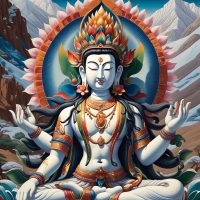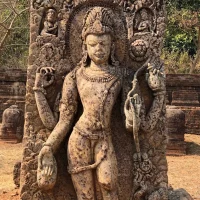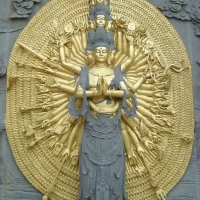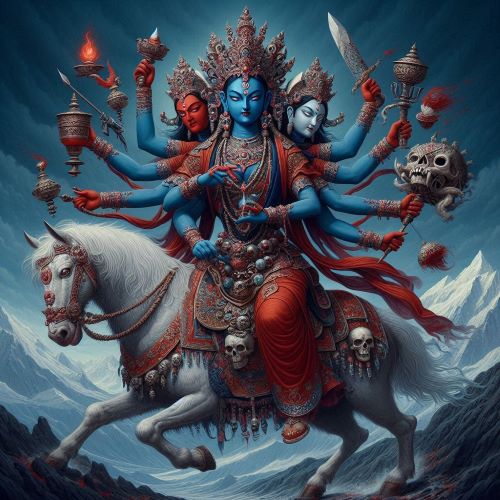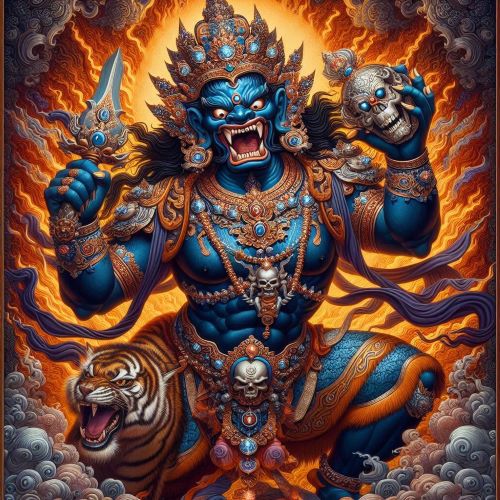Avalokiteshvara : The Compassionate One
Listen
At a glance
| Description | |
|---|---|
| Origin | Tibetan Mythology |
| Classification | Gods |
| Family Members | N/A |
| Region | Tibet, China, Nepal, India |
| Associated With | Compassion, Helping |
Avalokiteshvara
Introduction
Avalokiteshvara, revered as Chenrezig in Tibetan Buddhism, holds profound significance as a bodhisattva—a being who aspires to achieve Buddhahood for the betterment of all sentient beings. He epitomizes boundless compassion, serving as the embodiment of the altruistic aspirations of all Buddhas. Beyond being a mere deity, Avalokiteshvara represents the quintessence of compassion, permeating the spiritual fabric of Tibet and extending its influence far beyond its borders. As Chenrezig, he symbolizes the compassionate resolve of a bodhisattva, an enlightened being who willingly postpones their own enlightenment to assist others on their path to liberation.
Physical Traits
Avalokiteshvara’s depictions abound with symbolism, each detail conveying profound meaning. Often depicted holding a lotus (padma), he symbolizes purity and spiritual awakening. In some portrayals, he appears in a pristine white hue, a visual representation of the immaculate nature of his compassion. His countenance exudes serenity, with multiple arms and eyes reflecting his boundless awareness and compassion. In Tibetan art, Avalokiteshvara is frequently shown seated, emanating compassion through every gesture.
His iconic form features a thousand arms, each adorned with an open palm bearing an eye, illustrating his ability to reach out to all beings in need and perceive their suffering from myriad perspectives. These eyes symbolize the diverse skillful means he employs to alleviate suffering and guide beings towards liberation. Often depicted with eleven heads, each crowned with a Buddha, Avalokiteshvara embodies ultimate wisdom and enlightened awareness in its varied forms. The central head, typically white, signifies his fundamental nature of compassion.
Adorned with precious jewels, Avalokiteshvara’s attire symbolizes the noble qualities he embodies, including generosity, patience, and perseverance. In his hand, he holds a lotus flower, a potent symbol of purity and spiritual growth, thriving even amidst the murky waters of existence. Each aspect of Avalokiteshvara’s depiction serves to convey his unwavering commitment to compassion and his tireless efforts to alleviate the suffering of all sentient beings.
Family
Avalokiteshvara’s association with Amitabha Buddha is deeply ingrained in Tibetan mythology, where he is often regarded as the earthly manifestation of the eternal Buddha Amitabha. This connection is visually represented by the figure of Amitabha in Avalokiteshvara’s headdress. While Avalokiteshvara’s familial lineage is not extensively emphasized in Tibetan mythology, he is commonly linked with Amitabha Buddha, the central figure of the Pure Land tradition, and is considered his spiritual emanation. Some interpretations even depict Avalokiteshvara as the offspring of Amitabha, further reinforcing their spiritual bond.
The lineage of Avalokiteshvara within Tibetan mythology is intricate and multifaceted. Regarded as the spiritual son of Amitabha Buddha, Avalokiteshvara embodies the compassionate essence of his divine parent. However, various schools of Tibetan Buddhism offer differing perspectives on his origin. In some traditions, Avalokiteshvara is believed to be self-arisen, emerging from the quintessence of all Buddhas. Another narrative describes him as being born from a lotus flower that blossomed in the heart lake of Amitabha Buddha, symbolizing his innate purity and profound connection to enlightenment. These diverse interpretations reflect the richness and complexity of Avalokiteshvara’s mythological significance within Tibetan Buddhist traditions.
Other names
Avalokiteshvara’s presence is felt across different cultures, each bestowing upon him a unique name and interpretation. In Sanskrit, his name, “Avalokiteshvara,” signifies “the lord who looks down” or “the lord of what we see,” underscoring his role as a compassionate observer of worldly suffering. In Tibet, he is commonly known as Chenrezig, denoting “the one who looks with unwavering eye,” emphasizing his unwavering compassion and empathy towards all beings.
Across the vast landscape of Chinese Buddhism, Avalokiteshvara takes on the form of Guanyin, often worshipped in a feminine guise as the “Goddess of Mercy.” This portrayal highlights Avalokiteshvara’s nurturing and maternal qualities, embodying compassion in its most tender form. Similarly, in Japanese Buddhism, he is revered as Kannon or Kanzeon, the “Hearer of the World’s Cries,” epitomizing his attentive presence towards suffering beings and his readiness to alleviate their pain.
Powers and Abilities
Avalokiteshvara is revered for his boundless compassion, often termed as mahakaruṇā in Buddhist scriptures. As a bodhisattva, he embodies immense empathy and wisdom, utilizing these virtues as his primary powers. His commitment to altruism is so profound that he postpones his own attainment of Buddhahood until every sentient being on earth achieves liberation from the cycle of suffering and rebirth, known as samsara.
Believed to be responsive to the cries of sentient beings, Avalokiteshvara pledges boundless assistance to all who seek his help. The mantra “Om Mani Padme Hum” is intricately linked with his essence, believed to invoke his blessings and cleanse the mind. Avalokiteshvara’s ability to manifest in various forms and traverse different realms underscores his role as a universal protector and guide, demonstrating his unwavering dedication to alleviating suffering.
His powers extend far beyond mere compassion. Avalokiteshvara is renowned as the “Lord of Liberation,” possessing the capacity to steer individuals towards enlightenment through various means, tailored to their specific needs. Moreover, he is deeply associated with the concept of emptiness, a fundamental principle in Buddhist philosophy. Mastery of emptiness enables detachment from suffering and facilitates the journey towards ultimate liberation. With his thousand arms and eyes, Avalokiteshvara symbolizes boundless action and perception, ensuring that he can reach every being in need and guide them towards liberation from suffering.
Modern Day Influence
In today’s world, Avalokiteshvara’s influence permeates Tibetan Buddhism through the widespread usage of his mantra, “oṃ maṇi padme hūṃ,” which stands as the most popular mantra in this tradition. Many Tibetan Buddhists regard the Dalai Lama as the primary earthly embodiment of Chenrezig, further highlighting Avalokiteshvara’s enduring impact.
Even in contemporary times, Avalokiteshvara maintains a profound presence in Tibetan culture and beyond. His likeness graces temples, homes, and religious artifacts, serving as a constant emblem of compassion and empathy. The recitation of the mantra “Om Mani Padme Hum” remains a prevalent practice, with millions of Buddhists worldwide invoking Avalokiteshvara’s blessings through this sacred chant.
Moreover, Avalokiteshvara’s teachings on compassion continue to inspire countless individuals to engage in acts of kindness and altruism, transcending cultural and religious boundaries. His influence extends beyond the realms of ancient myths, resonating deeply with contemporary spiritual seekers.
In present-day Tibet, Avalokiteshvara remains a central figure in spiritual practices, with his image adorning temples and homes. Devotees chant his mantras, recite his prayers, and meditate upon his form, seeking solace and guidance in their spiritual journey. Beyond Tibet, Avalokiteshvara’s message of compassion resonates with individuals worldwide, serving as a beacon of hope and transformation amidst the complexities of modern life. His image serves as a potent reminder of the transformative power of empathy, inspiring positive change within oneself and the world at large.
Related Images
Frequently Asked Questions
What is lorem Ipsum?
I am text block. Click edit button to change this text. Lorem ipsum dolor sit amet, consectetur adipiscing elit. Ut elit tellus, luctus nec ullamcorper mattis, pulvinar dapibus leo.
What is lorem Ipsum?
I am text block. Click edit button to change this text. Lorem ipsum dolor sit amet, consectetur adipiscing elit. Ut elit tellus, luctus nec ullamcorper mattis, pulvinar dapibus leo.
What is lorem Ipsum?
I am text block. Click edit button to change this text. Lorem ipsum dolor sit amet, consectetur adipiscing elit. Ut elit tellus, luctus nec ullamcorper mattis, pulvinar dapibus leo.
What is lorem Ipsum?
I am text block. Click edit button to change this text. Lorem ipsum dolor sit amet, consectetur adipiscing elit. Ut elit tellus, luctus nec ullamcorper mattis, pulvinar dapibus leo.
What is lorem Ipsum?
I am text block. Click edit button to change this text. Lorem ipsum dolor sit amet, consectetur adipiscing elit. Ut elit tellus, luctus nec ullamcorper mattis, pulvinar dapibus leo.

